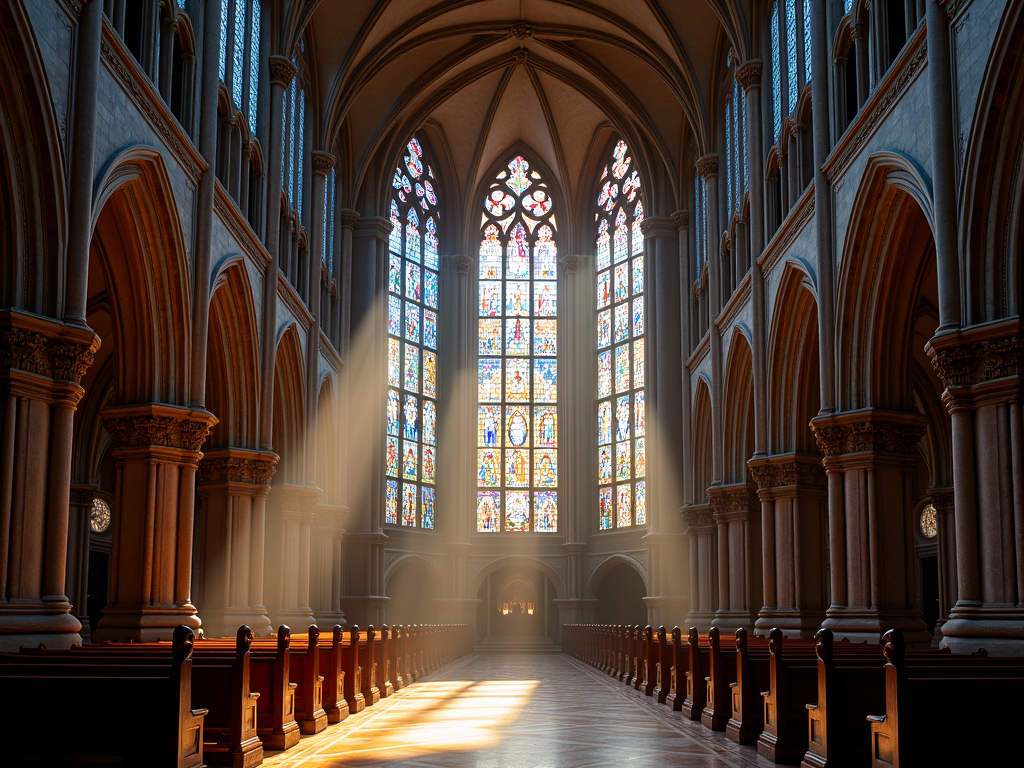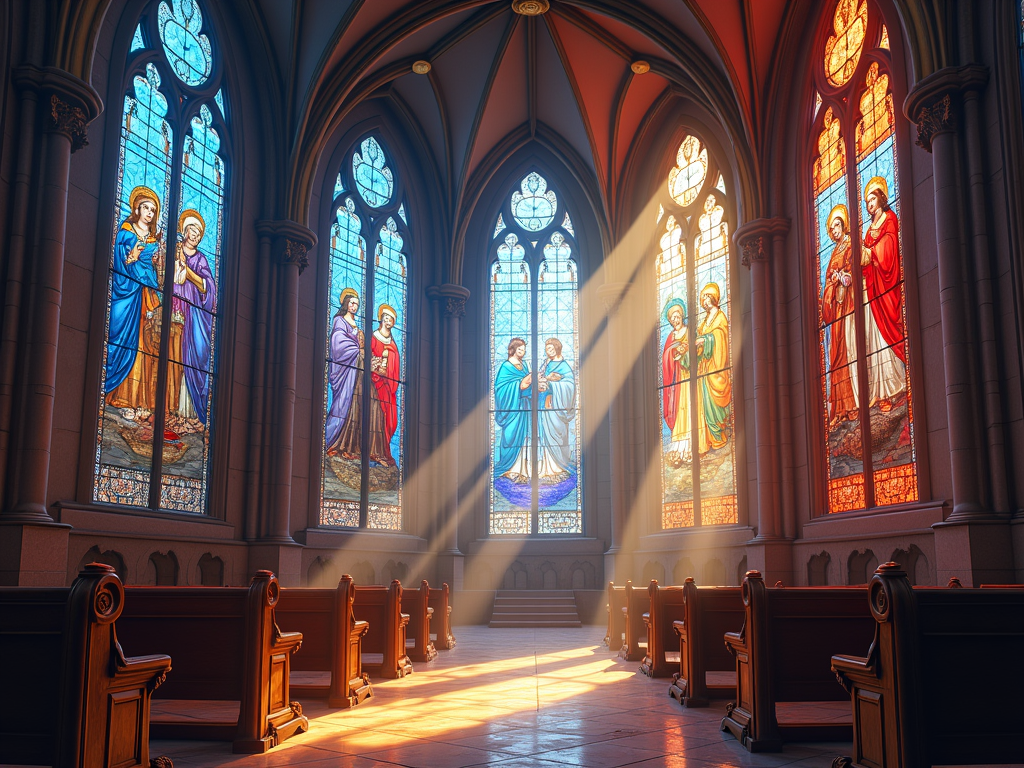
Key Takeaways
- Stained glass filters natural light through vibrant colors, casting dynamic patterns that shift as the sun moves across the sky.
- Medieval craftspeople selected colors with specific spiritual intent—blue represented heaven, red symbolized sacrifice, green depicted renewal, and gold expressed divine glory.
- These artistic windows acted as visual teaching tools, sharing biblical stories with congregations who couldn’t read text.
- Sunlight passing through colored glass panels transforms basic rooms into ethereal spaces that inspire spiritual reflection.
- Contemporary stained glass artists maintain traditional techniques while exploring modern themes, including social justice, environmental protection, and connections between different faiths.
Divine Light: How Stained Glass Creates Sacred Spaces
Light filtering through stained glass windows transforms ordinary spaces into sacred environments that connect us with the divine. I’ve seen firsthand how stained glass symbolizes spiritual transformation through its interaction with natural light, creating an otherworldly atmosphere that lifts our spirits beyond everyday existence.
The Power of Divine Illumination
The concept of divine light has deep roots in spiritual architecture, particularly in medieval Christian thought. Abbot Suger, the 12th-century architect of Saint-Denis basilica, introduced the revolutionary idea of ‘lux nova’ (new light) – believing that stained glass windows serve as spiritual vessels through which divine light enters sacred spaces. In his writings, Suger explained how “The dull mind rises to truth through that which is material,” suggesting that physical beauty can lead us to spiritual understanding.
Creating Transcendent Experiences
The way colored light affects our spiritual experience isn’t just artistic – it’s deeply psychological and emotional. As sunlight streams through these windows, it creates:
- Dancing patterns that shift throughout the day, reflecting the dynamic nature of spiritual journey
- Color combinations that affect our mood and spiritual receptiveness
- Visual stories that teach and inspire through biblical narratives
- Moments of quiet contemplation as light transforms ordinary spaces
- A physical representation of divine presence through illumination
This spiritual dimension of stained glass has made it an essential element in religious architecture throughout history. The colored light serves as a bridge between the physical and spiritual realms, creating an environment where worshippers can feel closer to the divine. Much like how candlelight has been used in spiritual practices, stained glass harnesses light to create a sacred atmosphere.
The transformative power of stained glass lies in its ability to filter and modify natural light, turning ordinary sunbeams into something extraordinary. When light passes through these colored panes, it bathes the interior space in rich hues that seem to dance and shift with the movement of the sun. This effect creates an atmosphere that many describe as transcendent – a space where the physical and spiritual worlds meet.
I’ve noticed that different styles of stained glass can create varied spiritual experiences. Gothic cathedral windows with their soaring heights emphasize vertical movement, drawing our eyes and spirits upward. Meanwhile, more intimate chapel windows can create a sense of peaceful contemplation through their smaller scale and focused light patterns.
The Sacred Language of Color in Medieval Glass
Color Symbolism in Sacred Art
I’ve found that stained glass colors hold deep spiritual meanings that transform ordinary windows into powerful spiritual messages. Each hue in medieval stained glass serves as a carefully chosen symbol, creating a visual language that speaks directly to the soul.
The rich blues in traditional stained glass windows connect viewers to heavenly realms and divine truth. I’ve noticed these deep azure tones frequently appear in scenes depicting the Virgin Mary, representing her faithfulness and celestial nature. Red glass carries profound significance in religious artwork, symbolizing Christ’s sacrifice through its blood-red intensity while also representing divine love and the passion of martyrs.
The verdant green sections aren’t just decorative – they carry messages of spiritual growth and renewal. I can point to countless examples where craftsmen used green glass to represent hope and the cycle of rebirth in nature. Yellow and gold tones shine with particular brilliance, casting a warm glow that medieval artists used to represent divine light and God’s majesty.
Symbolic Meanings of Stained Glass Colors
Here are the primary colors and their spiritual meanings in medieval stained glass:
- White glass represents absolute purity and holiness, often used in scenes of the resurrection.
- Purple sections denote both royal authority and periods of penitence in the Christian calendar.
- Violet combines spiritual love with humility, frequently appearing in scenes of transformation.
- Grisaille (gray and white patterns) creates contrast and allows sacred colors to shine more brilliantly.
These symbolic colors work together in historic church windows to tell stories and convey spiritual teachings. The placement of each colored piece isn’t random – it’s part of a larger visual sermon that medieval churchgoers could understand, even if they couldn’t read traditional text.
The Transformative Power of Light and Color
The artisans who created these windows used their understanding of light and color to craft powerful spiritual experiences. I’ve seen how morning sunlight streaming through these carefully chosen hues can transform a church interior, creating an otherworldly atmosphere that enhances worship and contemplation. The biblical symbolism in stained glass continues to resonate with modern viewers, proving the enduring power of this ancient art form.
Through my research of fascinating stained glass facts, I’ve discovered that these windows don’t just illuminate spaces – they illuminate minds and spirits through their carefully chosen colors. The strategic use of color and light creates spaces where the physical and spiritual worlds meet, enhanced by the spiritual ambiance of candlelight in traditional settings.

Telling Biblical Stories Through Glass
Stained glass windows played a vital role in medieval religious education, acting as what scholars termed the ‘Biblia Pauperum’ – the Poor Man’s Bible. I can’t overstate how these stunning symbolic stained glass artworks helped spread biblical teachings to those who couldn’t read.
Biblical Storytelling in Glass
The artisans crafted elaborate scenes pairing Old and New Testament stories side by side, creating powerful connections for viewers. These historic stained glass windows displayed familiar stories like Noah’s Ark alongside Jesus calming the storm, highlighting God’s power over water in both narratives.
Here are the key ways biblical stories came alive through stained glass:
- Narrative sequences showing saints’ life stories from birth to death
- Donor portraits featuring local patrons kneeling in prayer, connecting the community to their faith
- Major biblical events like the Crucifixion depicted in striking detail and meaningful colors
- Parables such as the Good Samaritan illustrated to teach moral lessons
- Prophetic scenes from the Old Testament paired with their New Testament fulfillment
The biblical significance of stained glass went far beyond simple decoration. Each window incorporated specific symbols and visual cues that medieval churchgoers would have recognized instantly. A lamb represented Christ, while a serpent indicated evil – this clear visual language helped convey complex theological concepts to all viewers regardless of their literacy level.
Masters of stained glass developed sophisticated techniques to draw viewers into these sacred stories. They used lead lines to direct the eye through narrative sequences and carefully selected glass colors to highlight important figures and emphasize emotional moments. This artistic mastery created fascinating stained glass features that still captivate viewers today.
The spiritual power of these windows was enhanced by their interaction with candlelight and natural light throughout the day. As sunlight streamed through the colored glass, it bathed congregants in vibrant hues, creating an otherworldly atmosphere that reinforced the sacred nature of both the space and the stories depicted.
Masterpieces of Medieval Sacred Glass
Medieval stained glass represents one of the most stunning achievements in religious art history. I’ve found that these spectacular windows served as more than mere decorations – they acted as spiritual beacons, transforming sunlight into divine illumination. The rich history of stained glass craftsmanship reached its pinnacle during the Gothic period.
Iconic Cathedral Windows
The windows of Chartres Cathedral stand as a testament to medieval artistry, with 176 spectacular stained glass windows covering an astounding 28,954 square feet. Each panel tells biblical stories through carefully chosen colors and symbols. Sainte-Chapelle in Paris showcases equally impressive dimensions with 15 towering windows, each reaching 50 feet high, creating an almost weightless appearance of colored light.
Evolution of Sacred Glass
Augsburg Cathedral houses some of the oldest surviving stained glass figures, dating back to the 11th and 12th centuries. These Romanesque pieces demonstrate the early mastery of the craft, setting the stage for later innovations. The Gothic architectural revolution, spanning from 1150 to 1500, brought significant changes that transformed religious symbolism in stained glass. New building techniques allowed for larger windows, replacing solid walls with vast expanses of colored glass. This architectural breakthrough created spaces where biblical narratives could be told through light, making sacred stories accessible to all believers, regardless of literacy.
I’ve noticed that these medieval masterpieces continue to captivate visitors today, their fascinating artistic features serving as bridges between the physical and spiritual realms. The interplay of light through these ancient windows creates an atmosphere that many find deeply moving, connecting modern viewers to centuries of spiritual tradition through the medium of colored glass.

Modern Spiritual Expression in Glass
Contemporary stained glass art carries deep spiritual meaning across faiths and cultures, building on traditional stained glass symbolism while embracing new forms of expression. I’ve seen how modern artists have transformed this ancient medium to speak to today’s spiritual seekers.
Notable Contemporary Sacred Works
The spiritual power of modern stained glass shines brilliantly in Marc Chagall’s masterpiece at the Hadassah Medical Center in Jerusalem. These stunning windows blend symbolic colors and meanings with Jewish traditions, creating a space where healing and spirituality merge. In Dallas, the Chapel of Thanksgiving features an extraordinary spiral design that draws visitors upward in contemplation, mixing spiritual light symbolism with modern architectural elements.
Johannes Schreiter’s minimalist approach has redefined religious stained glass artistry, proving that simple forms can carry profound spiritual weight. His work shows how contemporary artists can honor historical stained glass traditions while creating something fresh and meaningful.
Modern spiritual glass art addresses current themes that resonate with contemporary congregations and communities:
- Social justice messaging through symbolic imagery and color
- Interfaith dialogue represented by combined religious symbols
- Environmental stewardship themes featuring natural elements
- Abstract designs that encourage personal interpretation
- Cultural diversity celebrated through varied artistic styles
These modern interpretations of stained glass don’t just decorate spaces – they create environments for meditation, reflection, and spiritual connection. Artists now mix traditional techniques with innovative approaches, using light and color to spark emotional and spiritual responses in viewers.
Sources:
The Stained Glass Museum, Ely. “Stained Glass Museum”
“History of Stained Glass.” British Society of Master Glass Painters
“Stained Glass.” Victoria and Albert Museum
“Chartres Cathedral”
“Sainte Chapelle, Paris, France”
Raguin, Virginia Chieffo. Stained Glass: Radiant Art. The J. Paul Getty Museum, 2013
Morris, Richard. Time’s Anvil: England, Archaeology and the Imagination. Phoenix, 2013
Panofsky, Erwin, editor and translator. Abbot Suger on the Abbey Church of St. Denis and Its Art Treasures. Princeton University Press, 1979
Lee, Lawrence; Seddon, George; Stephens, Francis. Stained Glass. Mitchell Beazley, 1982
